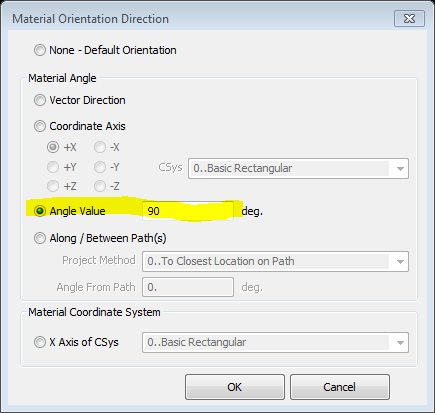MrRogers1987
Aerospace
- Feb 20, 2014
- 45
I am trying to run a plane strain model that has several components which do not have isotropic properties. They are made from composite layups, but I have calculated equivalent orthopedic properties for the layup schedule. These numbers worked fine when I was running a solid model with MAT11. I would also like to recover stresses/strains in local material coordinates, and from what I can tell the only way to do that with plane strain elements is to use non-isotropic material cards.
Now I have a plane strain model of a different section of this assembly. I am using the PPLANE property card with CPLSTN4 elements and MAT3 card to try and apply the orthotropic material properties. When I set the MAT3 cards up as isotropic (i.e. assign the same numbers for E_x, E_y, etc...) the model runs fine. As soon as I start applying actual orthotropic properties however, I get pivot ratio errors on every node in the 2 in-plane DOF.
Since the model runs with isotropic properties I don't think this has anything to do with the model boundary conditions, which is usually the culprit with this kind of error. Almost all the grid points have negative terms in the matrix diagonal, the ones that don't still have a negative ratio (I'm not sure if that is a symptom of anything specific, I just thought it might be worth noting). I have tried swapping around the different components in the MAT3 card, thinking that maybe I had misinterpreted the direction assignment, but this didn't solve the issue.
Does anyone have any experience in this kind of analysis that could suggest some additional debugging steps? Or perhaps a better/more robust combination of element/property/material cards? Also, any other techniques for recovering elemental data in local coordinates for a plane strain model?
Now I have a plane strain model of a different section of this assembly. I am using the PPLANE property card with CPLSTN4 elements and MAT3 card to try and apply the orthotropic material properties. When I set the MAT3 cards up as isotropic (i.e. assign the same numbers for E_x, E_y, etc...) the model runs fine. As soon as I start applying actual orthotropic properties however, I get pivot ratio errors on every node in the 2 in-plane DOF.
Since the model runs with isotropic properties I don't think this has anything to do with the model boundary conditions, which is usually the culprit with this kind of error. Almost all the grid points have negative terms in the matrix diagonal, the ones that don't still have a negative ratio (I'm not sure if that is a symptom of anything specific, I just thought it might be worth noting). I have tried swapping around the different components in the MAT3 card, thinking that maybe I had misinterpreted the direction assignment, but this didn't solve the issue.
Does anyone have any experience in this kind of analysis that could suggest some additional debugging steps? Or perhaps a better/more robust combination of element/property/material cards? Also, any other techniques for recovering elemental data in local coordinates for a plane strain model?

